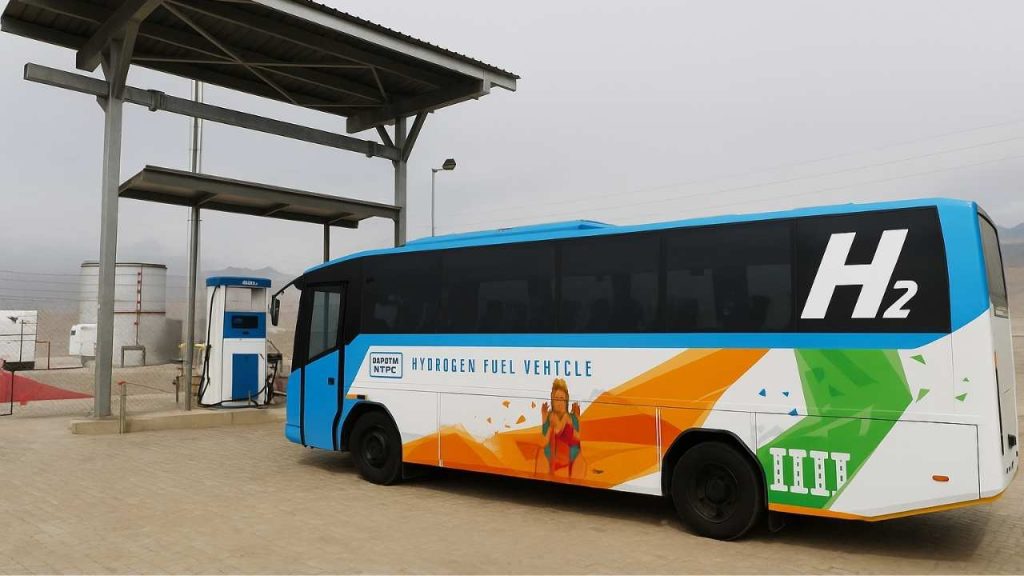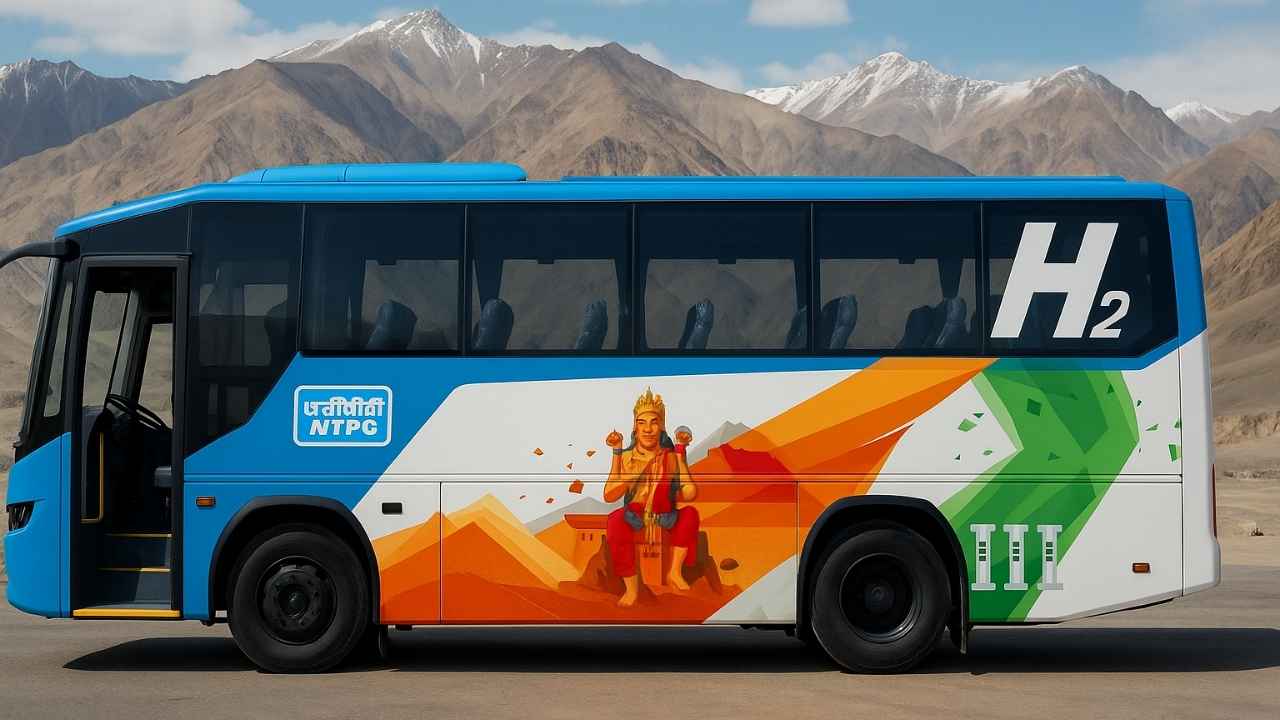In a groundbreaking step toward sustainable public transport, Ladakh has become the first region in India to commercially deploy hydrogen fuel cell buses. State-owned NTPC Limited formally handed over five hydrogen-powered buses to the Ladakh administration this week, marking the nation’s first commercial use of such clean mobility technology.
What makes this move even more significant is the location—Leh, a high-altitude desert city known for its extreme weather and challenging terrain. These buses will operate at an altitude of 11,562 feet, the world’s highest motorable road region, where traditional vehicles struggle to function efficiently.
Key Highlights:
- India’s first commercial hydrogen fuel cell buses launched in Leh, Ladakh.
- Operated at 11,562 feet, the world’s highest motorable region.
- Backed by a 1.7 MW solar-powered hydrogen fuelling station.
- Project to reduce 350 metric tonnes of CO₂ annually and generate 230 metric tonnes of oxygen.
- Part of India’s National Green Hydrogen Mission and NTPC’s green energy strategy.
Hydrogen Fuel Cell Buses Make History in Leh: A Big Win for Green Mobility

The handover ceremony took place at NTPC’s Green Hydrogen Mobility Station in the Palam area of Leh. The buses, designed to withstand sub-zero temperatures and high-altitude conditions, are part of a collaborative project between NTPC and the Ladakh administration. They are now operated by the Sindhu Infrastructure Development Corporation (SIDCO), a local state-run entity.
This initiative is a major milestone under India’s National Green Hydrogen Mission, which was launched in 2023 with a budget of ₹19,744 crore. The mission aims to make India a global hub for the production, usage, and export of green hydrogen. The Leh hydrogen bus project stands as one of the first real-world applications of this national vision.
Powered by the Sun and Hydrogen
What sets this project apart is its commitment to complete environmental sustainability. The buses are supported by a hydrogen fuelling station co-located with a 1.7 MW solar power plant, ensuring that the hydrogen used is green and renewable. Hydrogen is dispensed at 350 bar pressure, enabling efficient refuelling even in severe weather conditions.
This setup is expected to generate around 230 metric tonnes of oxygen annually and reduce carbon emissions by 350 metric tonnes. These environmental benefits are comparable to the carbon offset provided by 13,000 trees, a substantial contribution to India’s decarbonization efforts.
Hydrogen Fuel Cell Buses as a Model for India’s Green Mobility Push
NTPC, India’s largest integrated power utility, currently has over 81 GW of installed power capacity and aims to reach 60 GW of renewable energy capacity by 2032. The Leh project is a part of this strategic shift toward clean energy. It also builds on NTPC’s earlier achievement of establishing India’s first high-pressure hydrogen fuelling station in Leh in November 2024.
The buses in Leh will act as a live test case for hydrogen-powered public transport in other ecologically and strategically sensitive regions, including border areas and difficult terrains.
Hydrogen Mobility Gaining Momentum Nationwide
While Leh is the first to implement hydrogen fuel cell buses in commercial public transport, the shift toward hydrogen mobility is not limited to Ladakh. Across India, Tata Motors has been running pilot tests of hydrogen-powered fuel cell electric buses (FCEVs) and recently began testing hydrogen-powered trucks across key national freight corridors. These initiatives are being supported by various government programs to explore hydrogen as a viable alternative fuel.
Why Ladakh Was Chosen
Ladakh’s extreme conditions make it a natural testing ground for hydrogen technology. At nearly 11,000 feet above sea level, with rocky terrain and sub-zero temperatures, operating conventional vehicles is a challenge. Successfully deploying hydrogen buses here proves the durability, reliability, and adaptability of hydrogen fuel cell technology.
According to an NTPC spokesperson, “Leh has demonstrated that hydrogen is not just a concept for the future—it can power real public mobility today, even in the harshest of environments.”
Final Remarks
As these buses begin their operations, Ladakh is not only paving the way for sustainable public transport but also setting a powerful example for the rest of India. The success of this green mobility experiment could accelerate the adoption of hydrogen fuel in other regions, pushing India closer to its clean energy goals.
Related Sources: TOI, EV Story
Dr. Suvankar Das is a scientific advisor by profession, associated with a CRO organization. He pursued his doctoral degree in Chemistry in 2015. Later, he worked as a postdoctoral researcher & scientist in a couple of institutes/companies.
Besides his scientific journey, Dr. Das is also a passionate traveler and travel blogger. He loves to share all his travel experiences with other travelers so that everyone can enjoy hassle-free holidays with their own tour plans.
He believes, the most beautiful thing in this world is the WORLD itself. so there is no way to live like a clock; rather live it like a compass!






![Top Travel News of July 2024 [First Fortnight ] 8 Read more about the article Top Travel News of July 2024 [First Fortnight ]](https://travelentice.com/wp-content/uploads/2024/07/Top-travel-news-July-2024-300x169.jpg)
